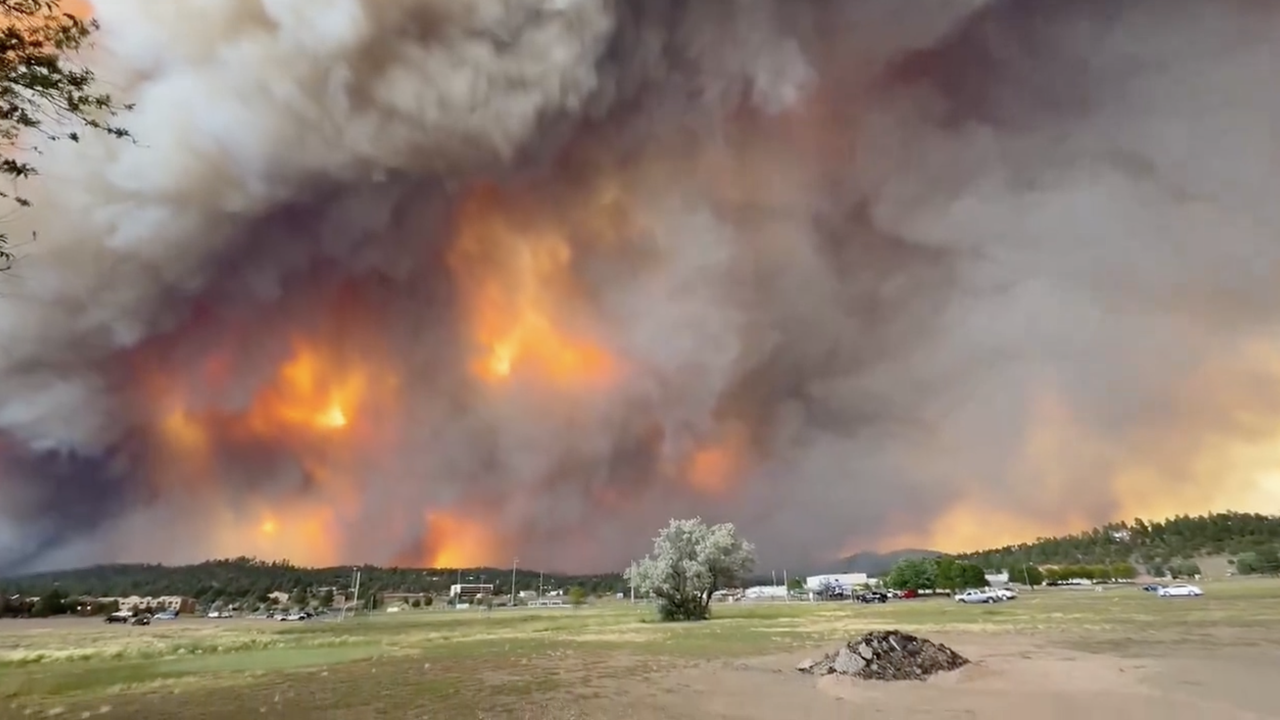
Two growing wildfires near a popular New Mexico resort town and historic Native American reservation killed at least two people and destroyed more than 1,400 structures as officials rushed to evacuate thousands of people on Tuesday.
The big picture: Fresh mandatory evacuation orders were issued on Wednesday in Lincoln County, N.M., including for Ruidoso, a mountain hamlet that’s a hub for ski resorts and hiking trails, due to what the National Weather Service described as “life-threatening burn scar flash flooding” in the village nearly 7,700 residents.
- The uncontained wildfires were among 21 large fires burning across the western U.S. and impacting air quality amid a record heat wave and high winds — the bulk of them in N.M. (5) and California (6), per the National Interagency Fire Center.
Due to the Flash Flood Warning issued by NWS the Ruidoso OEM is pulling all operations out of the below areas & are evacuating anyone still there to higher ground.
Upper Canyon
Eagle Drive
Sleepy Hollow
Country Club
Lower Gavilan
Lower Paradise Canyon
Two Rivers
Carrizo Canyon pic.twitter.com/FjHTnUN6VX— Village of Ruidoso (@VillageRuidoso) June 19, 2024
Situation report: Gov. Michelle Lujan Grisham declared an emergency Tuesday in the state’s Lincoln County and the Mescalero Apache Reservation and ordered additional National Guard members to the scene.
- N.M. State Police spokesperson Wilson Silver in an emailed statement Wednesday evening confirmed the deaths of two people in the South Fork Fire a day earlier when the blaze quickly grew in size.
- Officers found a body in the driver’s seat of a vehicle during the fire in Ruidoso, Lincoln County, that could not immediately be identified.
- The other person killed in the fire was Patrick Pearson, 60, whose body was found on a roadside near the Swiss Chalet Motel.
- “He had sustained numerous burns from the fire, where he succumbed to his injuries,” Wilson said.
Threat level: The New Mexico wildfires that ignited Monday saw the evacuation of some 8,000 people on Tuesday, including the entire village of Ruidoso.
- “An extremely dangerous situation is unfolding” due to the flooding, the NWS’ Albuquerque office warned in a Wednesday afternoon forecast discussion.
- Radar indicated up to baseball-sized hail with the storm over the
South Fork burn scar and rainfall estimates of up to 3.5″ were indicated in this region, according to the update at 3:15pm local time. - “This is a terribly extreme situation given the recent fires in the
Ruidoso area,” the NWS said. “Debris flows may be catastrophic within several canyons in the Rio Ruidoso watershed.”
State of play: The South Fork Fire had burned across more than 16,600 acres and the Salt Fire that’s also burning across Mescalero tribal land had burned over 7,000 acres as of Wednesday afternoon, according to the New Mexico Forestry Division. Both were 0% contained.
- The fires have caused “significant disruptions” to shipping and delivery services in the area, officials in Ruidoso reported.
- In California, the Sites Fire that ignited on Monday was burning across nearly 15,700 acres in Colusa County after it more than doubled in size overnight and was 5% contained as of Wednesday afternoon, according to Cal Fire.
- The Post Fire that ignited Saturday had razed a similar amount of acreage in Los Angeles and Ventura counties and was 39% contained.
The #PointFire in Sonoma County remains at 1,207 acres & 50% contained. Control lines are secured around the entire perimeter and crews are working to hold those lines. Heavy mop-up operations are underway to address heat sources inside the perimeter & mitigate any hazards. pic.twitter.com/Pys9gZmqC9
— CAL FIRE LNU (@CALFIRELNU) June 19, 2024
Context: Climate change is a key driver behind increased wildfire risk and it’s leading to more instances of critical fire weather across the U.S. and other parts of the world, studies show.
- Much of New Mexico is experiencing an ongoing drought, and studies show climate change is increasing extreme weather swings from drought to flood and back again.
Go deeper: Blazing temperatures, wildfire smoke compounded by warming climate
Editor’s note: This a breaking news story. Please check back for updates.

Post a Comment